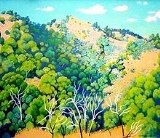
Jean Isherwood
Encyclopedia
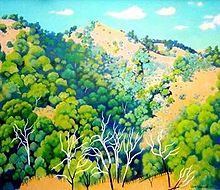
Biography
Isherwood was born in MarrickvilleMarrickville, New South Wales
Marrickville, a suburb of Sydney's Inner West is located 7 kilometres south-west of the Sydney central business district in the state of New South Wales, Australia and is the largest suburb in the Marrickville Council local government area...
, Sydney in 1911. At the age of fourteen she won a scholarship to the National Art School
National Art School
The National Art School is an art school in Sydney, Australia. It is a Public Company Limited by Guarantee with a board of directors. It has Institutional Registration and Course Accreditation supported by the DET Higher Education Directorate....
at East Sydney Technical College. In the dramatic architectural surroundings which had previously comprised Darlinghurst Gaol
Darlinghurst Gaol
Darlinghurst Gaol was an Australian prison located in Darlinghurst, New South Wales. The site is bordered by Victoria, Burton and Forbes streets, with entrances on Forbes and Burton Streets.-History:...
, Isherwood learned an appreciation of linear perspective and accurate draughtsmanship which she later applied with great skill to her rural landscapes.
In 1929 she commenced work as a fashion artist with an advertising agency, continuing her studies for a further five years at the National Art School and Royal Art Society as an evening student. She later worked as a freelance artist and illustrator. Isherwood's first exhibited work with the Australian Watercolour Institute
Australian Watercolour Institute
The Australian Watercolour Institute is a non-profit membership organization devoted to the advancement of watercolour painting in Australia. It was founded in 1923 by six painters in Sydney, and was modeled after the Royal Watercolour Society and the American Watercolor Society.-History:The AWI's...
in 1934 was a small painting of a building site. From that time she became a frequent exhibitor in major art exhibitions. She was a student of Antonio Dattilo Rubbo.
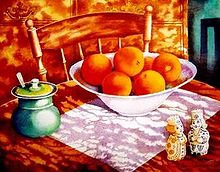
Springwood, New South Wales
Springwood is a town in the Blue Mountains, New South Wales, Australia. Springwood is located 72 kilometres west of Sydney in the local government area of the City of Blue Mountains. At the 2006 census, Springwood had a population of 8,210 people. It is largely Anglo-Celtic.Springwood is near the...
in the Blue Mountains and had two children, Josephine and Jacqueline. They divorced in 1948 After the divorce, she returned to fashion drawing and illustration to support herself, pursuing her art interests, as she had before, on the weekend. She took up full-time painting in 1952.
From 1961 to 1974, Isherwood taught at the National Art School. This was a period of conflicting views in the teaching of art in Sydney, a time when a disciplinary approach to the skills of perspective, anatomy and design was considered by many of both the teachers and students alike as passé and unnecessary to the creation of works of art, the stylistic vogue in teaching being Abstract Expressionism. http://www.aare.edu.au/01pap/pee01238.htm http://www.australianprints.gov.au/Default.cfm?MnuID=SYM2/Backen Jean Isherwood was one of the several teachers who determinedly maintained the opposite position. An exacting teacher, she stalked her perspective drawing students with a kneadable putty eraser in hand, challenging their skills with arrangements of battered metal rubbish bins, piles of broken chairs and, on rainy days, a dripping sixteen-rib umbrella. It was said of Miss Isherwood that no student escaped her class without being able to draw parallel lines and precise ellipses, freehand.
In 1959 Isherwood travelled around New South Wales
New South Wales
New South Wales is a state of :Australia, located in the east of the country. It is bordered by Queensland, Victoria and South Australia to the north, south and west respectively. To the east, the state is bordered by the Tasman Sea, which forms part of the Pacific Ocean. New South Wales...
by car. From that time onwards, she became primarily a landscape painter, and, through her attachment to the countryside, a major exhibitor in the art competitions held in conjunction with the shows run by the local Agricultural Societies and culminating each year in the Sydney Royal Easter Show
Sydney Royal Easter Show
The Sydney Royal Easter Show, also known as the Royal Easter Show or simply The Show, is an annual show held in Sydney, Australia over two weeks around Easter.It is run by the Royal Agricultural Society of New South Wales and was first held in 1823...
with its exhibition attracting hundreds of entrants. From 1950 until her death Isherwood won more than 100 first prizes in various art competitions.
"My Country"
In 1974 Isherwood made a trip to Central AustraliaCentral Australia
Central Australia/Alice Springs Region is one of the five regions in the Northern Territory. The term Central Australia is used to describe an area centred on Alice Springs in Australia. It is sometimes referred to as Centralia; likewise the people of the area are sometimes called Centralians...
. On her return journey, passing through Tamworth, New South Wales
Tamworth, New South Wales
Tamworth is a city in the New England region of New South Wales, Australia. Straddling the Peel River, Tamworth, which contains an estimated population of 47,595 people, is the major regional centre for southern New England and in the local government area of Tamworth Regional Council. The city...
, she was struck by the beauty of the countryside of that region and in 1976 purchased a property at Moonbi, where she was to live until 1987 when she moved to Tamworth.

Dorothea Mackellar
Isobel Marion Dorothea Mackellar, OBE was an Australian poet and fiction writer.The only daughter of noted physician and parliamentarian Sir Charles Mackellar, she was born in Sydney in 1885...
's iconic poem, "My Country", in which an Australian explains to an English listener how she is not moved by the gentle landscape of England with soft, dim skies and green lanes, but by the harsh beauty of Australia.
The second verse is as follows-
- I love a sunburnt country,
- A land of sweeping plains,
- Of rugged mountain ranges,
- Of droughts and flooding rains
- I love her far horizons,
- I love her jewel sea.
- Her beauty and her terror,
- The wide, brown land for me!
In 1982 Isherwood heard on the radio that a statue was to be erected as a memorial to Dorothea Mackellar
Dorothea Mackellar
Isobel Marion Dorothea Mackellar, OBE was an Australian poet and fiction writer.The only daughter of noted physician and parliamentarian Sir Charles Mackellar, she was born in Sydney in 1885...
at Gunnedah, on Australia Day, 26 January 1983. Isherwood had long had it in mind to create a series of works illustrating the writer's most famous poem. Prompted by the imminent celebration, Isherwood created a series of thirty four watercolour paintings for exhibition in Gunnedah in conjunction with the unveiling of the statue.
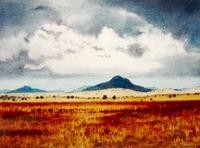
Darling River
The Darling River is the third longest river in Australia, measuring from its source in northern New South Wales to its confluence with the Murray River at Wentworth, New South Wales. Including its longest contiguous tributaries it is long, making it the longest river system in Australia.The...
, a bushfire in the Blue Mountains and a forest of ringbarked trees near Armidale. This latter painting is one of Isherwood's most masterly works, showing her exceptional control over both the watercolour technique and perspective. As is usual in a watercolour, those parts of the painting which are white are left unpainted, in this case a forest of dead tree trunks. In the narrow spaces between the array of trees Isherwood has painted a landscape that rolls away in layers to the distance. The subject would have been impressive, in oils. In watercolour, however, the technical demands are extraordinary, as is the facility with which it has been achieved. The paintings were eventually put on permanent display in the Gunnedah Bicentennial Regional Gallery. Isherwood set about painting a series of oils based on the watercolours. These were exhibited at the Artarmon Galleries in Sydney in 1986.
In November 2004, Isherwood exhibited with seven other well-known Australian artists, all over the age of eighty at an exhibition called Eighty and Over, at Max Taylor's Gallery at Summer Hill, Sydney.
Jean Isherwood died at home on 6 January 2006, aged 94 years. Her funeral notice requested that those attending should wear bright colours.
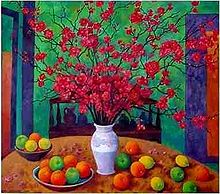
Exhibitions, societies and awards
From 1946, Isherwood had nineteen exhibitions, of which three were with her daughter, Jaqueline Dabron, in the state capitals of Sydney, Brisbane and Melbourne. A retrospective exhibition was held in the regional galleries of Tamworth and Mussellbrook. Her work is represented in the National Gallery of AustraliaNational Gallery of Australia
The National Gallery of Australia is the national art gallery of Australia, holding more than 120,000 works of art. It was established in 1967 by the Australian government as a national public art gallery.- Establishment :...
, Canberra; the Art Gallery of NSW; the Howard Hinton Collection, Armidale Regional Gallery; the Tamworth Art Gallery, the National Portrait Gallery, Canberra and many other regional galleries and private collections.
Isherwood was a member of the Australian Watercolour Institute from 1948 and a member of the Royal Art Society from 1976, being elected a Fellow in 1982. In 1994 Jean Isherwood was awarded the Order of Australia Medal
Order of Australia
The Order of Australia is an order of chivalry established on 14 February 1975 by Elizabeth II, Queen of Australia, "for the purpose of according recognition to Australian citizens and other persons for achievement or for meritorious service"...
for her contribution to the Arts for painting in oils and watercolours.
External links
- Art Gallery of NSW
- National Gallery of Australia
- Australian Watercolour Institute
- National Portrait Gallery, Canberra
- New England Regional Art Museum, Armidale, NSW
- Dorothea Mackellar Society
- The National Art School, Sydney
- The Royal Agricultural Society of New South Wales
- Gunnedah, NSW
- Jean Isherwood at Australian Art

